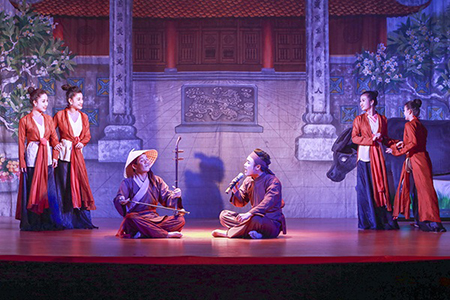Whole villages take part in Cheo. Traditionally, the stage is a sedge mat spread in the courtyard of the communal house. A backdrop may provide the scenery. The musicians sit on two sides of the performing mat, and the audience surrounds the stage. Cheo musicians act as a kind of Greek chorus, commenting on and participating in the action. The dialogue between artists and musicians sometimes even includes the audience to create an exciting atmosphere similar to a modern "happening."

In the past, cheo artists were farmers without much money for staging, musical instruments, costumes, or props. Their plays weren't lavish affairs, yet through convention and stylization in speech and singing, they created space (mountains, rivers. oceans, etc.), time (day, night, dozens of years, etc.), weather (rain, sun, etc.) and backgrounds (fire, fight, etc.) in the imaginations of the audience sitting around the small mat-stage. Thi Kinh, The Goddess of Mercy (Quan Am Thi Kinh) provides an example. To describe the heroine on her way to seek Buddhist conversion, the artists sing "Long Journey" (Duong Truong) followed by drums and bells to replicate the sounds of a pagoda. A song about Buddha follows. Other examples of these techniques include singing a song about rowing a boat to convey the idea of crossing a river and then a different song about the landscape to convey the idea of arrival at the other bank.
A Cheo performance follows a regular scenario beginning as follows: A drum rolls. The artists respond by calling "Da!" (Yes!) The music begins. Two buffoons dance with Torches to keep the audience back from the mat. Two performers - a man and a woman - sing the first two sentences, and the other performers harmonies with them.
The performers love to the prelude, where an actress sings, praising the king, who had brought prosperity and a peaceful life to the people. She summarizes and comments on the play about to follow. The main performance begins. In addition to special techniques for breathing, speaking, singing, walking, etc., artists pay attention to twisting their hands, wrists, and arms. All these constitute the basic cheo movements.



